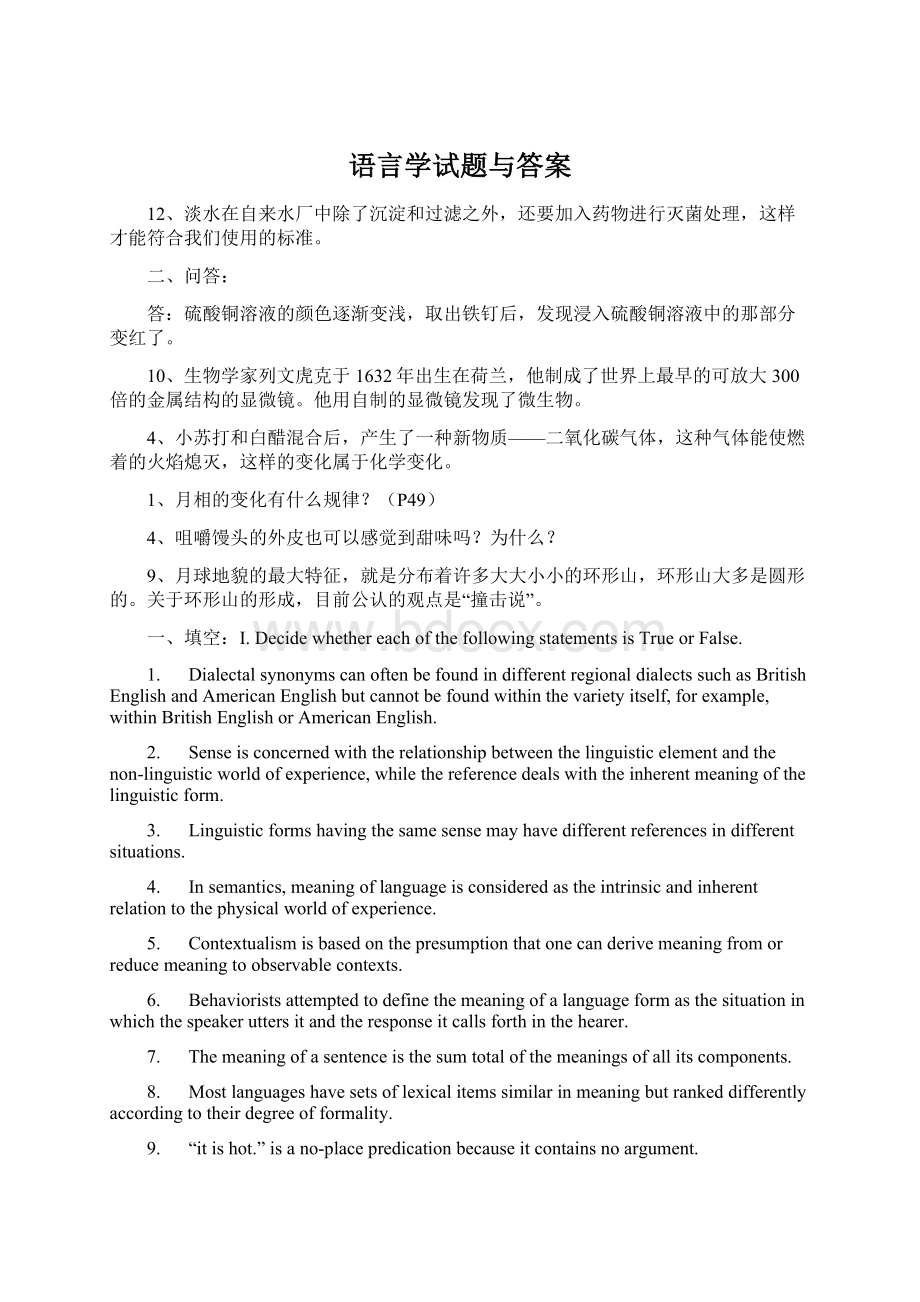语言学试题与答案.docx
《语言学试题与答案.docx》由会员分享,可在线阅读,更多相关《语言学试题与答案.docx(9页珍藏版)》请在冰豆网上搜索。

语言学试题与答案
12、淡水在自来水厂中除了沉淀和过滤之外,还要加入药物进行灭菌处理,这样才能符合我们使用的标准。
二、问答:
答:
硫酸铜溶液的颜色逐渐变浅,取出铁钉后,发现浸入硫酸铜溶液中的那部分变红了。
10、生物学家列文虎克于1632年出生在荷兰,他制成了世界上最早的可放大300倍的金属结构的显微镜。
他用自制的显微镜发现了微生物。
4、小苏打和白醋混合后,产生了一种新物质——二氧化碳气体,这种气体能使燃着的火焰熄灭,这样的变化属于化学变化。
1、月相的变化有什么规律?
(P49)
4、咀嚼馒头的外皮也可以感觉到甜味吗?
为什么?
9、月球地貌的最大特征,就是分布着许多大大小小的环形山,环形山大多是圆形的。
关于环形山的形成,目前公认的观点是“撞击说”。
一、填空:
I.DecidewhethereachofthefollowingstatementsisTrueorFalse.
1. DialectalsynonymscanoftenbefoundindifferentregionaldialectssuchasBritishEnglishandAmericanEnglishbutcannotbefoundwithinthevarietyitself,forexample,withinBritishEnglishorAmericanEnglish.
2. Senseisconcernedwiththerelationshipbetweenthelinguisticelementandthenon-linguisticworldofexperience,whilethereferencedealswiththeinherentmeaningofthelinguisticform.
3. Linguisticformshavingthesamesensemayhavedifferentreferencesindifferentsituations.
4. Insemantics,meaningoflanguageisconsideredastheintrinsicandinherentrelationtothephysicalworldofexperience.
5. Contextualismisbasedonthepresumptionthatonecanderivemeaningfromorreducemeaningtoobservablecontexts.
6. Behavioristsattemptedtodefinethemeaningofalanguageformasthesituationinwhichthespeakeruttersitandtheresponseitcallsforthinthehearer.
7. Themeaningofasentenceisthesumtotalofthemeaningsofallitscomponents.
8. Mostlanguageshavesetsoflexicalitemssimilarinmeaningbutrankeddifferentlyaccordingtotheirdegreeofformality.
9. “itishot.”isano-placepredicationbecauseitcontainsnoargument.
10. Ingrammaticalanalysis,thesentenceistakentobethebasicunit,butinsemanticanalysisofasentence,thebasicunitispredication,whichistheabstractionofthemeaningofasentence.
II.Fillineachofthefollowingblankswithonewordwhichbeginswiththelettergiven.
11. S________canbedefinedasthestudyofmeaning.
12. Theconceptualistviewholdsthatthereisnod______linkbetweenalinguisticformandwhatitrefersto.
13. R______meanswhatalinguisticformreferstointhereal,physicalworld;itdealswiththerelationshipbetweenthelinguisticelementandthenon-linguisticworldofexperience.
14. Wordsthatarecloseinmeaningarecalleds________.
15. Whentwowordsareidenticalinsound,butdifferentinspellingandmeaning,theyarecalledh__________.
16. R_________oppositesarepairsofwordsthatexhibitthereversalofarelationshipbetweenthetwoitems.
17. C____analysisisbaseduponthebeliefthatthemeaningofawordcanbedividedintomeaningcomponents.
18. Whetherasentenceissemanticallymeaningfulisgovernedbyrulescalleds________restrictions,whichareconstraintsonwhatlexicalitemscangowithwhatothers.
19. Ana________isalogicalparticipantinapredication,largelyidenticalwiththenominalelement(s)inasentence.
20. Accordingtothen____theoryofmeaning,thewordsinalanguagearetakentobelabelsoftheobjectstheystandfor.
III.Therearefourchoicesfollowingeachstatement.Markthechoicethatcanbestcompletethestatement.
21.Thenamingtheoryisadvancedby________.
A.Plato
B.Bloomfield
C.GeoffreyLeech
D.Firth
22.“Weshallknowawordbythecompanyitkeeps.”Thisstatementrepresents_______.
A.theconceptualistview
B.contexutalism
C.thenamingtheory
D.behaviorism
23.Whichofthefollowingisnottrue?
A. Senseisconcernedwiththeinherentmeaningofthelinguisticform.
B. Senseisthecollectionofallthefeaturesofthelinguisticform.
C. Senseisabstractandde-contextualized.
D. Senseistheaspectofmeaningdictionarycompilersarenotinterestedin.
24.“CanIborrowyourbike?
”_______“Youhaveabike.”
A.issynonymouswith
B.isinconsistentwith
C.entails
D.presupposes
25.___________isawayinwhichthemeaningofawordcanbedissectedintomeaningcomponents,calledsemanticfeatures.
A.Predicationanalysis
B.Componentialanalysis
C.Phonemicanalysis
D.Grammaticalanalysis
26.“alive”and“dead”are______________.
A.gradableantonyms
B.relationalopposites
C.complementaryantonyms
D.Noneoftheabove
27._________dealswiththerelationshipbetweenthelinguisticelementandthenon-linguisticworldofexperience.
A.Reference
B.Concept
C.Semantics
D.Sense
28.___________referstothephenomenonthatwordshavingdifferentmeaningshavethesameform.
A.Polysemy
B.Synonymy
C.Homonymy
D.Hyponymy
29.Wordsthatarecloseinmeaningarecalled______________.
A.homonyms
B.polysemy
C.hyponyms
D.synonyms
30. Thegrammaticalityofasentenceisgovernedby_______.
A.grammaticalrules
B.selectionalrestrictions
C.semanticrules
D.semanticfeatures
IV.Definethefollowingterms.
31. semantics
32. sense
33. reference
34. synonymy
35. polysemy
36. homonymy
37. homophones
38. Homographs
39. completehomonyms
40. hyponymy
41. antonymy
42. componentialanalysis
43. grammaticalmeaning
44. predication
45. Argument
46. predicate
47. Two-placepredication
V.Answerthefollowingquestions.
48. Whydowesaythatameaningofasentenceisnotthesumtotalofthemeaningsofallitscomponents?
49. Whatiscomponentialanalysis?
Illustrateitwithexamples.
50. Howdoyoudistinguishbetweenentailmentandpresuppositionintermsoftruthvalues?
51. Howdoyouaccountforsuchsenserelationsbetweensentencesassynonymousrelation,inconsistentrelationintermsoftruthvalues?
52. Accordingtothewaysynonymsdiffer,howmanygroupscanweclassifysynonymsinto?
Illustratethemwithexamples.
53. Whatarethemajorviewsconcerningthestudyofmeaning?
Howtheydiffer?
答:
①可以节约能源;②减少对环境的污染;③降低成本。
SuggestedAnswers
I.DecidewhethereachofthefollowingstatementsisTrueorFalse.
l.F
2.F
3.T
4.F
5.T
6.T
7.F
8.T
9.T
10.T
II.Fillineachofthefollowingblankswithonewordwhichbeginswiththelettergiven.
11. Semantics
12. direct
13. Reference
14. synonyms
15. homophones
16. Relational
17. Componential
18. selectional
19. argument
20. naming
III.Therearefourchoicesfollowingeachstatement.Markthechoicethatcanbestcompletethestatement.
2l.A
22.B
23.D
24.D
25.B
26.C
27.A
28.C
29.D
30.A
IV.Definethefollowingterms.
31.Semantics:
Semanticscanbesimplydefinedasthestudyofmeaninginlanguage.
32.Sense:
Senseisconcernedwiththeinherentmeaningofthelinguisticform.Itisthecollectionofallthefeaturesofthelinguisticform;itisabstractandde-contextualized.
33.Reference:
Referencemeanswhatalinguisticformreferstointhereal,physicalworld;itdealswiththerelationshipbetweenthelinguisticelementandthenon-linguisticworldofexperience
34.Synonymy:
Synonymyreferstothesamenessorclosesimilarityofmeaning.
35.Polysemy:
Polysemyreferstothefactthatthesameonewordmayhavemorethanonemeaning.
36.Homonymy:
Homonymyreferstothephenomenonthatwordshavingdifferentmeaningshavethesameform,i.e.differentwordsareidenticalinsoundorspelling,orinboth.
37.Homophones:
Whentwowordsareidenticalinsound,theyarecalledhomophones.
38.Homographs:
Whentwowordsareidenticalinspelling,theyarehomographs.
39.Completehomonyms:
Whentwowordsareidenticalinbothsoundandspelling,theyarecalledcompletehomonyms.
40.Hyponymy:
Hyponymyreferstothesenserelationbetweenamoregeneral,moreinclusivewordandamorespecificword.
41.Antonymy:
Antonymyreferstotherelationofoppositenessofmeaning.
42.Componentialanalysis:
Componentialanalysisisawaytoanalyzewordmeaning.Itwasproposedbystructuralsemanticists.Theapproachisbasedonthebeliefthatthemeaningofawordcanbedividedintomeaningcomponents,whicharecalledsemanticfeatures.
43.Thegrammaticalmeaning:
Thegrammaticalmeaningofasentencereferstoitsgrammaticality,i.e.itsgrammaticalwell-formedness.Thegrammaticalityofasentenceisgovernedbythegrammaticalrulesofthelanguage.
44.Predication:
Thepredicationistheabstractionofthemeaningofasentence.
45.Argument:
Anargumentisalogicalparticipantinapredication.Itisgenerallyidenticalwiththenominalelement(s)inasentence.
46.Predicate:
Apredicateissomethingthatissaidaboutanargumentoritstatesthelogicalrelationlinkingtheargumentsinasentence.
47.Two-placepredication:
Atwo-placepredicationisonewhichcontainstwoarguments.
V.Answerthefollowingquestions.
48. Whydowesaythatameaningofasentenceisnotthesumtotalofthemeaningsofallitscomponents?
Themeaningofasentenceisnotthesumtotalofthemeaningsofallitscomponentsbecauseitcannotbeworkedoutbyaddingupallthemeaningsofitsconstituentwords.Forexample:
(A)Thedogbittheman.
(B)Themanbitthedog.
Ifthemeaningofasentencewerethesumtotalofthemeaningsofallitscomponents,thentheabovetwosentenceswouldhavethesamemeaning.Infacttheyaredifferentinmeanings.
Asweknow,therearetwoaspectstosentencemeaning:
grammaticalmeaningandsemanticmeaning.Thegrammaticalmeaningsof“thedog”and“theman”in(A)aredifferentfromthegrammaticalmeaningsof“thedog”and“theman”in(B).T